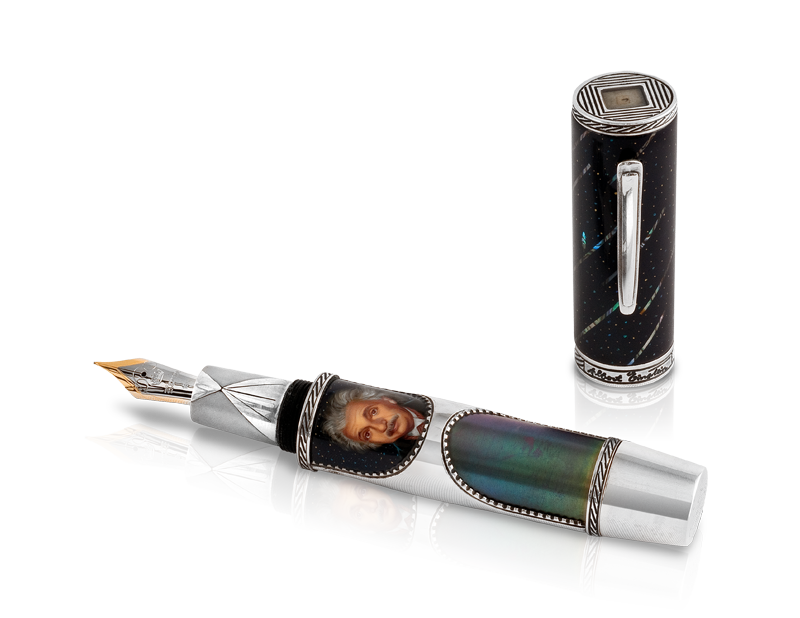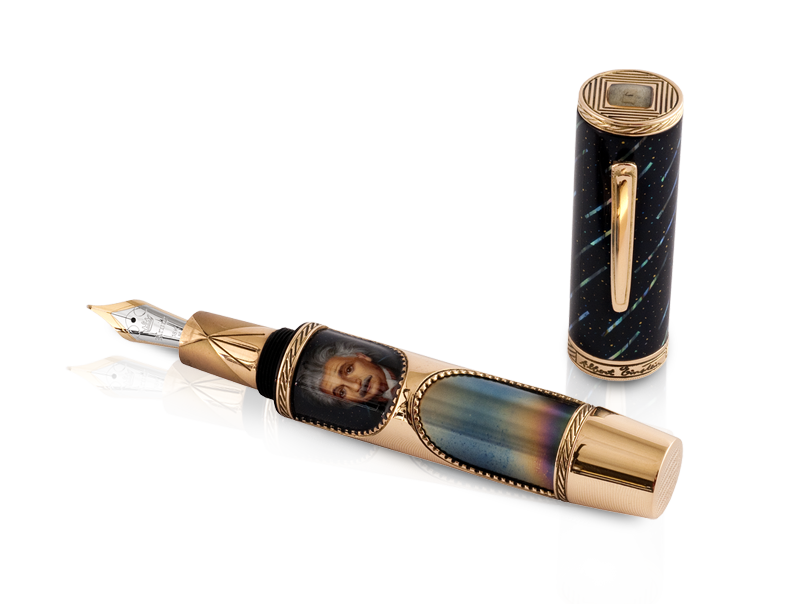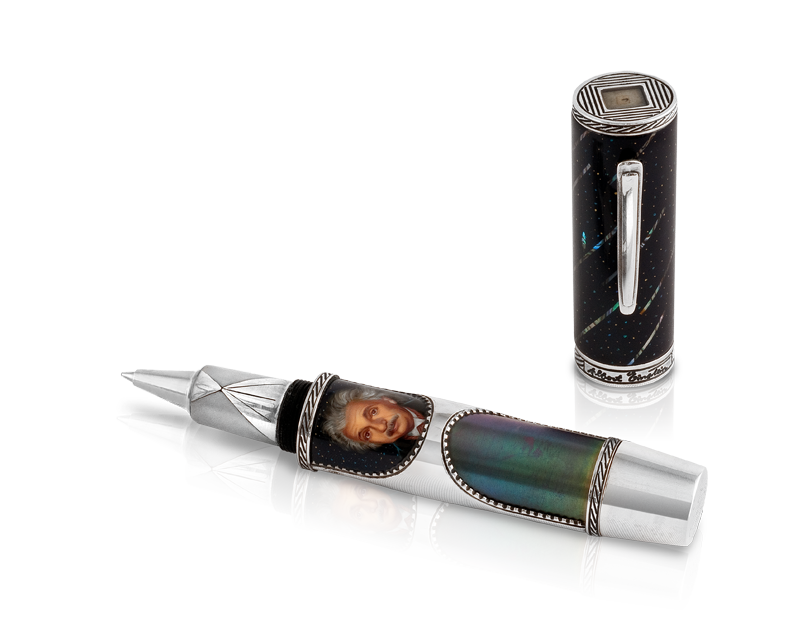In 1905 and 1915 Albert Einstein published scientific papers that would change the world. The first paper was on the Special Theory of Relativity and was controversial because it challenged Isaac Newton’s view of the universe, which had stood for two centuries. The Newtonian view held that space is a fixed physical reality through which stars and planets move. Newton also viewed time as an unvarying absolute that flowed from an infinite past to an infinite future. In contrast, Einstein’s theory held that stars, planets and galaxies move in relation to one another rather than in relation to a fixed exclusive space. The implication was that one’s position in the universe controls one’s viewpoint. Einstein’s work on space and time ultimately demolished Newton’s view of a fixed universe.
Ten years later Einstein built on this theory with the equation E=mc2 or energy equals mass multiplied by the speed of light squared. Known as the General Theory of Relativity, this equation concluded that everything in the universe is a repository of latent energy. Furthermore, converting a small amount of mass would yield a tremendous amount of energy, as eventually happened with the atom bomb. Einstein termed the General Theory “the happiest thought of my life” and it later proved to be one of the most influential theories of the 20th Century, providing a scientific foundation for the “big bang” theory of creation.
Einstein’s thinking was a generation ahead of its time and because not even members of the Nobel Prize committee could comprehend it, he was nominated for and denied the award eight times between 1910 and 1921. In 1922 a number of leading scientists wrote letters to the Nobel committee in support of Einstein’s nomination. The most emphatic letter, from Marcel Brillouin, stated: “ Imagine for a moment what the general opinion will be fifty years from now if the name Einstein does not appear on the list of laureates.” He did win the prize that year for “his services to Theoretical Physics and especially for his discovery of the photoelectric effect.” He did not win for his work on relativity, which continued to baffle most of the scientific community.
Since his death in 1955 at the age of 76, Einstein’s work has been verified by numerous discoveries that support the big bang theory of creation. His work on a unified field theory of the universe is also all the rage in modern physics and may in fact be the dominant thread in scientific thought for the past two thousand years. Einstein was thirty years ahead of his time in that he was trying to link electricity and magnetism with gravity while skipping the intermediate stage of nuclear force. Scientists now understand nuclear force and a group of scientists are now trying to achieve Einstein’s vision of a super quantum theory by taking modern string theory to a higher level. That is the living legacy of Albert Einstein. His work is still relevant and thought provoking a half-century after his death.
LISTEN TO AUDIO
SPECIFICATIONS
A culmination of luxurious components, the Krone Albert Einstein pen is a stunning invention. The body is composed of two fused barrels; a gradient colored titanium barrel and a hand-painted mother of pearl barrel. The painting on the mother of pearl depicts Einstein’s portrait on one side and on the other side is a rendition of our solar system. Over this barrel is a sterling silver overlay which exposes the colored titanium and painting.
 The galactic cap is painted black, yet exposes beautiful slivers of colored abalone. Encapsulated on the top of the cap is a unique single character from one of Albert Einstein’s authentic handwritten formulas. The nib casing represents the refraction of light. Einstein’s signature is sculpted into the band at the base of the cap.
The galactic cap is painted black, yet exposes beautiful slivers of colored abalone. Encapsulated on the top of the cap is a unique single character from one of Albert Einstein’s authentic handwritten formulas. The nib casing represents the refraction of light. Einstein’s signature is sculpted into the band at the base of the cap.
Available in a worldwide Limited Edition of 288 fountain pens and 28 rollerballs. Also available, are 18 rose gold fountain pens. Piston Fill. F, M and B.
In 1905 and 1915 Albert Einstein published scientific papers that would change the world. The first paper was on the Special Theory of Relativity and was controversial because it challenged Isaac Newton’s view of the universe, which had stood for two centuries. The Newtonian view held that space is a fixed physical reality through which stars and planets move. Newton also viewed time as an unvarying absolute that flowed from an infinite past to an infinite future. In contrast, Einstein’s theory held that stars, planets and galaxies move in relation to one another rather than in relation to a fixed exclusive space. The implication was that one’s position in the universe controls one’s viewpoint. Einstein’s work on space and time ultimately demolished Newton’s view of a fixed universe.
Ten years later Einstein built on this theory with the equation E=mc2 or energy equals mass multiplied by the speed of light squared. Known as the General Theory of Relativity, this equation concluded that everything in the universe is a repository of latent energy. Furthermore, converting a small amount of mass would yield a tremendous amount of energy, as eventually happened with the atom bomb. Einstein termed the General Theory “the happiest thought of my life” and it later proved to be one of the most influential theories of the 20th Century, providing a scientific foundation for the “big bang” theory of creation.
Einstein’s thinking was a generation ahead of its time and because not even members of the Nobel Prize committee could comprehend it, he was nominated for and denied the award eight times between 1910 and 1921. In 1922 a number of leading scientists wrote letters to the Nobel committee in support of Einstein’s nomination. The most emphatic letter, from Marcel Brillouin, stated: “ Imagine for a moment what the general opinion will be fifty years from now if the name Einstein does not appear on the list of laureates.” He did win the prize that year for “his services to Theoretical Physics and especially for his discovery of the photoelectric effect.” He did not win for his work on relativity, which continued to baffle most of the scientific community.
Since his death in 1955 at the age of 76, Einstein’s work has been verified by numerous discoveries that support the big bang theory of creation. His work on a unified field theory of the universe is also all the rage in modern physics and may in fact be the dominant thread in scientific thought for the past two thousand years. Einstein was thirty years ahead of his time in that he was trying to link electricity and magnetism with gravity while skipping the intermediate stage of nuclear force. Scientists now understand nuclear force and a group of scientists are now trying to achieve Einstein’s vision of a super quantum theory by taking modern string theory to a higher level. That is the living legacy of Albert Einstein. His work is still relevant and thought provoking a half-century after his death.
LISTEN TO AUDIO
SPECIFICATIONS
A culmination of luxurious components, the Krone Albert Einstein pen is a stunning invention. The body is composed of two fused barrels; a gradient colored titanium barrel and a hand-painted mother of pearl barrel. The painting on the mother of pearl depicts Einstein’s portrait on one side and on the other side is a rendition of our solar system. Over this barrel is a sterling silver overlay which exposes the colored titanium and painting.
 The galactic cap is painted black, yet exposes beautiful slivers of colored abalone. Encapsulated on the top of the cap is a unique single character from one of Albert Einstein’s authentic handwritten formulas. The nib casing represents the refraction of light. Einstein’s signature is sculpted into the band at the base of the cap.
The galactic cap is painted black, yet exposes beautiful slivers of colored abalone. Encapsulated on the top of the cap is a unique single character from one of Albert Einstein’s authentic handwritten formulas. The nib casing represents the refraction of light. Einstein’s signature is sculpted into the band at the base of the cap.
Available in a worldwide Limited Edition of 288 fountain pens and 28 rollerballs. Also available, are 18 rose gold fountain pens. Piston Fill. F, M and B.
In 1905 and 1915 Albert Einstein published scientific papers that would change the world. The first paper was on the Special Theory of Relativity and was controversial because it challenged Isaac Newton’s view of the universe, which had stood for two centuries. The Newtonian view held that space is a fixed physical reality through which stars and planets move. Newton also viewed time as an unvarying absolute that flowed from an infinite past to an infinite future. In contrast, Einstein’s theory held that stars, planets and galaxies move in relation to one another rather than in relation to a fixed exclusive space. The implication was that one’s position in the universe controls one’s viewpoint. Einstein’s work on space and time ultimately demolished Newton’s view of a fixed universe.
Ten years later Einstein built on this theory with the equation E=mc2 or energy equals mass multiplied by the speed of light squared. Known as the General Theory of Relativity, this equation concluded that everything in the universe is a repository of latent energy. Furthermore, converting a small amount of mass would yield a tremendous amount of energy, as eventually happened with the atom bomb. Einstein termed the General Theory “the happiest thought of my life” and it later proved to be one of the most influential theories of the 20th Century, providing a scientific foundation for the “big bang” theory of creation.
Einstein’s thinking was a generation ahead of its time and because not even members of the Nobel Prize committee could comprehend it, he was nominated for and denied the award eight times between 1910 and 1921. In 1922 a number of leading scientists wrote letters to the Nobel committee in support of Einstein’s nomination. The most emphatic letter, from Marcel Brillouin, stated: “ Imagine for a moment what the general opinion will be fifty years from now if the name Einstein does not appear on the list of laureates.” He did win the prize that year for “his services to Theoretical Physics and especially for his discovery of the photoelectric effect.” He did not win for his work on relativity, which continued to baffle most of the scientific community.
Since his death in 1955 at the age of 76, Einstein’s work has been verified by numerous discoveries that support the big bang theory of creation. His work on a unified field theory of the universe is also all the rage in modern physics and may in fact be the dominant thread in scientific thought for the past two thousand years. Einstein was thirty years ahead of his time in that he was trying to link electricity and magnetism with gravity while skipping the intermediate stage of nuclear force. Scientists now understand nuclear force and a group of scientists are now trying to achieve Einstein’s vision of a super quantum theory by taking modern string theory to a higher level. That is the living legacy of Albert Einstein. His work is still relevant and thought provoking a half-century after his death.
LISTEN TO AUDIO
SPECIFICATIONS
A culmination of luxurious components, the Krone Albert Einstein pen is a stunning invention. The body is composed of two fused barrels; a gradient colored titanium barrel and a hand-painted mother of pearl barrel. The painting on the mother of pearl depicts Einstein’s portrait on one side and on the other side is a rendition of our solar system. Over this barrel is a sterling silver overlay which exposes the colored titanium and painting.
 The galactic cap is painted black, yet exposes beautiful slivers of colored abalone. Encapsulated on the top of the cap is a unique single character from one of Albert Einstein’s authentic handwritten formulas. The nib casing represents the refraction of light. Einstein’s signature is sculpted into the band at the base of the cap.
The galactic cap is painted black, yet exposes beautiful slivers of colored abalone. Encapsulated on the top of the cap is a unique single character from one of Albert Einstein’s authentic handwritten formulas. The nib casing represents the refraction of light. Einstein’s signature is sculpted into the band at the base of the cap.
Available in a worldwide Limited Edition of 288 fountain pens and 28 rollerballs. Also available, are 18 rose gold fountain pens. Piston Fill. F, M and B.
 The galactic cap is painted black, yet exposes beautiful slivers of colored abalone. Encapsulated on the top of the cap is a unique single character from one of Albert Einstein’s authentic handwritten formulas. The nib casing represents the refraction of light. Einstein’s signature is sculpted into the band at the base of the cap.
The galactic cap is painted black, yet exposes beautiful slivers of colored abalone. Encapsulated on the top of the cap is a unique single character from one of Albert Einstein’s authentic handwritten formulas. The nib casing represents the refraction of light. Einstein’s signature is sculpted into the band at the base of the cap. The galactic cap is painted black, yet exposes beautiful slivers of colored abalone. Encapsulated on the top of the cap is a unique single character from one of Albert Einstein’s authentic handwritten formulas. The nib casing represents the refraction of light. Einstein’s signature is sculpted into the band at the base of the cap.
The galactic cap is painted black, yet exposes beautiful slivers of colored abalone. Encapsulated on the top of the cap is a unique single character from one of Albert Einstein’s authentic handwritten formulas. The nib casing represents the refraction of light. Einstein’s signature is sculpted into the band at the base of the cap. The galactic cap is painted black, yet exposes beautiful slivers of colored abalone. Encapsulated on the top of the cap is a unique single character from one of Albert Einstein’s authentic handwritten formulas. The nib casing represents the refraction of light. Einstein’s signature is sculpted into the band at the base of the cap.
The galactic cap is painted black, yet exposes beautiful slivers of colored abalone. Encapsulated on the top of the cap is a unique single character from one of Albert Einstein’s authentic handwritten formulas. The nib casing represents the refraction of light. Einstein’s signature is sculpted into the band at the base of the cap.


